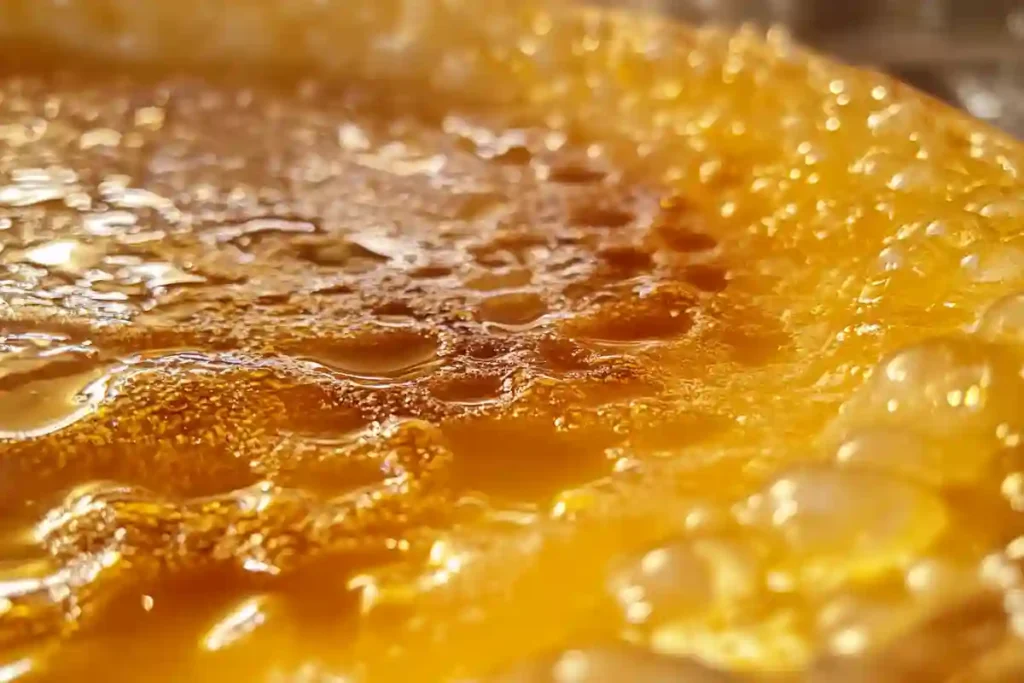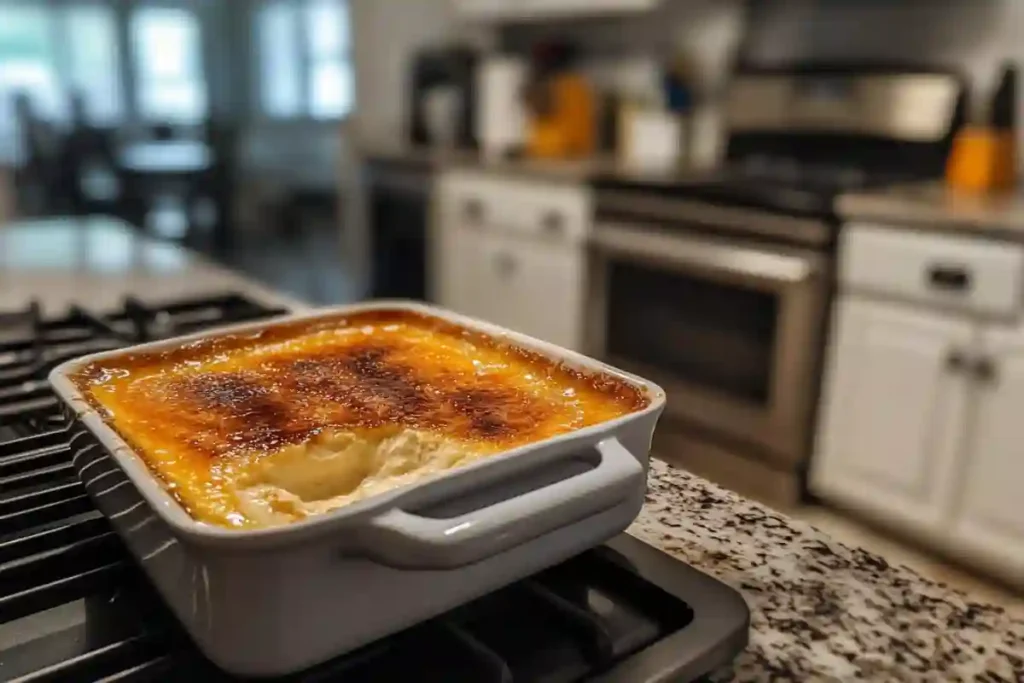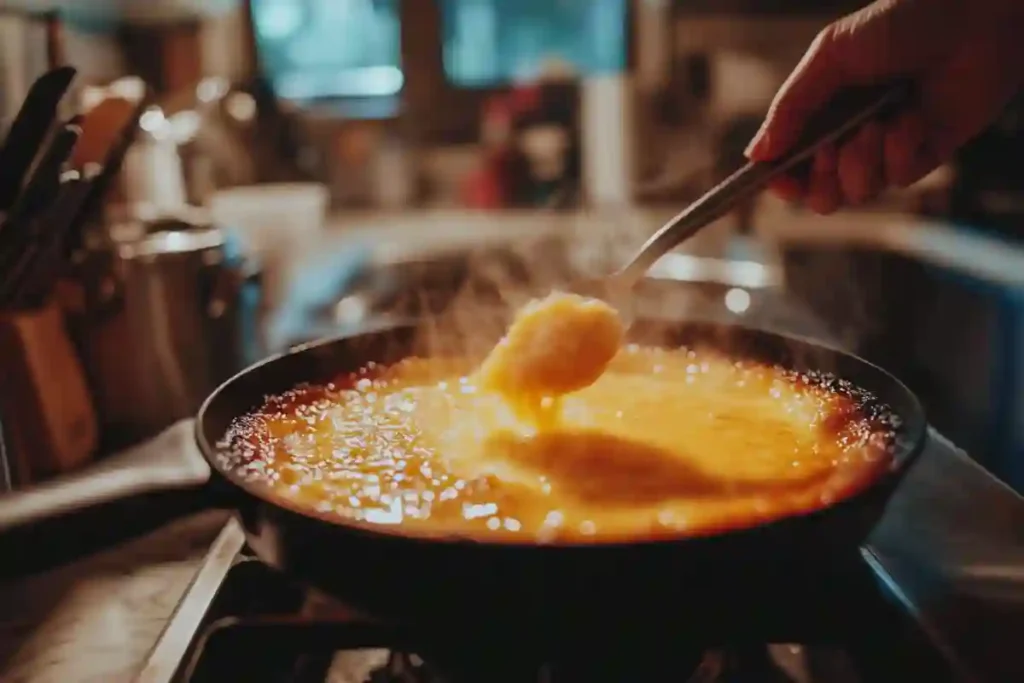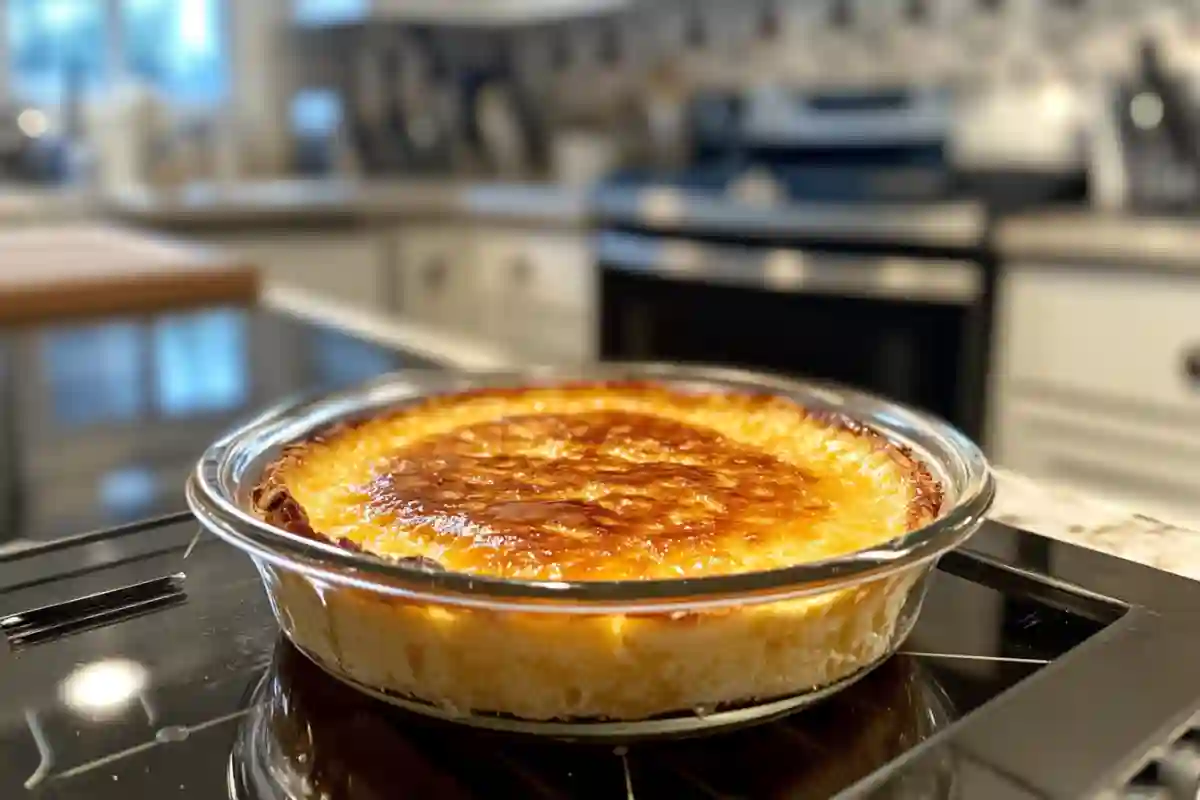Crème brûlée is a luscious dessert with a distinct flavor that many love. But what does crème brûlée really taste like? Let’s explore its unique combination of flavors and textures.
The Basics of Crème Brûlée’s Flavor Profile
To truly answer what does crème brûlée taste like, it’s important to understand the distinct elements that define this classic French dessert. Crème brûlée consists of a rich custard base topped with a crisp layer of caramelized sugar. This gives it a complex yet delightful taste that combines sweetness, richness, and a hint of bitter caramel.

The Creamy Custard Base
The custard base is the heart of crème brûlée. Made with simple ingredients like cream, egg yolks, sugar, and vanilla, it has a silky smooth texture. The taste of the custard is often described as rich, creamy, and velvety, with the prominent flavor of vanilla. The vanilla adds warmth and depth, while the cream provides a luxurious texture that feels indulgent and satisfying.
- Vanilla Essence: The most common flavor in crème brûlée is vanilla, giving it a gentle floral note.
- Egg Custard: The eggs provide a smooth, luscious body that creates the iconic custard flavor.
The Caramelized Sugar Topping
The caramelized sugar layer is what sets crème brûlée apart from other custard-based desserts. It provides a contrasting texture and a burst of flavor that makes each bite exciting. When sugar is caramelized, it becomes slightly bitter, balancing out the sweetness of the custard beneath. This bitter-sweet crunch is one of the most beloved aspects of the dessert.
- Sweet with a Touch of Bitterness: The caramelized top adds an extra layer of complexity.
- Crispy Texture: Breaking through the crisp sugar with a spoon is part of the iconic experience.
Flavor Variations of Crème Brûlée
While traditional crème brûlée is flavored with vanilla, there are numerous variations that add unique twists to its flavor profile. Here are some popular alternatives:
- Chocolate Crème Brûlée: Adds a deep, chocolatey flavor, making it richer.
- Citrus Infused: Lemon or orange zest brings a refreshing tang that balances the creaminess.
- Coffee Flavored: Espresso crème brûlée introduces bitter notes, ideal for coffee lovers.
Each variation maintains the fundamental elements of the dessert—a creamy custard base and a caramelized sugar topping—while introducing different flavors to excite your palate.
What Makes Crème Brûlée So Special?
Crème brûlée is more than just its taste. Its unique combination of flavors and textures make it an iconic dessert loved worldwide. The juxtaposition of the cold, creamy custard against the warm, crackling sugar layer creates a contrast that many find irresistible. The texture is every bit as important as the flavor when explaining what crème brûlée tastes like.
Texture Contrast: Silky and Crisp
The rich, silky smooth custard contrasts perfectly with the crisp caramelized topping, creating a unique texture experience. The crack of the sugar crust, followed by the softness of the custard, is an essential part of the experience of eating crème brûlée.
- Breaking the Sugar Crust: The crunch of the sugar crust is iconic—it’s a sensory delight.
- Smooth and Creamy: The custard underneath is smooth, offering a perfect balance.
The Role of Temperature
Temperature plays a key role in crème brûlée’s taste. Typically served chilled, the custard’s coolness contrasts with the slightly warm, freshly caramelized sugar layer on top. This contrast enhances the dessert’s depth, creating a multi-sensory experience that combines flavor, texture, and temperature.
Comparing Crème Brûlée to Similar Desserts
Crème brûlée shares similarities with other custard-based desserts like flan and panna cotta, but each has its own unique characteristics. Here’s how crème brûlée compares:
- Flan: While flan also has a caramel layer, it lacks the hardened, crisp top that crème brûlée is known for. Flan is generally softer and has a looser texture.
- Panna Cotta: This Italian dessert is creamier and does not have the caramelized sugar layer. Its texture is slightly firmer compared to crème brûlée.
Crème Caramel vs. Crème Brûlée
Another dessert that often gets compared to crème brûlée is crème caramel. Crème caramel features a soft caramel layer on top of a custard, rather than a hardened crust. The texture of crème caramel is smoother, with the caramel blending more fully into the custard. In contrast, crème brûlée’s caramel layer is crisp, adding a textural contrast that sets it apart.
Pot de Crème vs. Crème Brûlée
It is another dessert that resembles crème brûlée. Pot de crème is essentially a baked custard without the caramelized sugar layer. It’s more understated but equally creamy, and its flavor focuses more on the custard base itself without the crunch element.
The History of Crème Brûlée
Crème brûlée has a storied history that spans several centuries. Its origins are somewhat debated, with both France, Spain, and England claiming ownership. The first known recipe for crème brûlée appeared in a French cookbook from the late 17th century. Over time, the dessert has evolved, but its classic combination of custard and caramelized sugar has remained a favorite.
French Origins
The name “crème brûlée” is, of course, French for “burnt cream.” This name refers to the caramelized sugar layer that is created by torching the sugar on top. French chefs popularized the dessert, and it has since become a staple in high-end restaurants around the world.
Influence from Catalonia
Some historians trace crème brûlée back to Catalonia, where a similar dessert called Crema Catalana is enjoyed. Unlike traditional crème brûlée, Crema Catalana is flavored with citrus zest and sometimes cinnamon. It is also made with milk rather than heavy cream, giving it a slightly lighter texture.
Trinity Cream in England
In England, crème brûlée is often called Trinity Cream or Cambridge Burnt Cream. It became famous at Trinity College, Cambridge, where the college crest was stamped into the sugar crust before caramelizing. Trinity Cream has been enjoyed for centuries, adding another layer to the complex history of this iconic dessert.
How to Make the Perfect Crème Brûlée at Home
Making crème brûlée at home is easier than many might think, and it allows you to fully appreciate its flavor and texture. Here’s a simple guide to making perfect crème brûlée:
Ingredients You Need
- 2 cups heavy cream
- 5 egg yolks
- 1/2 cup granulated sugar (plus extra for caramelizing)
- 1 vanilla bean or 1 tsp pure vanilla extract
Step-by-Step Instructions
- Prepare the Custard: Heat the cream with the vanilla bean (if using) until it just starts to simmer. Remove from heat and let it infuse for 10 minutes.
- Mix Egg Yolks and Sugar: In a bowl, whisk together egg yolks and sugar until pale.
- Combine and Strain: Slowly pour the cream into the egg mixture while whisking continuously. Strain the mixture to remove any lumps or cooked egg.
- Bake the Custard: Pour the custard into ramekins and place them in a baking dish. Fill the dish with hot water halfway up the sides of the ramekins. Bake at 325°F (160°C) for 30-35 minutes or until set.
- Chill: Allow the custards to cool to room temperature, then refrigerate for at least 2 hours.
- Caramelize the Sugar: Sprinkle an even layer of sugar on top of each custard and use a kitchen torch to caramelize it until golden and crisp.
Tips for Success
- Even Sugar Layer: For the best crunch, make sure the sugar layer is even and not too thick.
- Chill Thoroughly: Chilling ensures the custard is properly set before caramelizing.
- Use a Kitchen Torch: A kitchen torch provides the most control when caramelizing the sugar.
Common Mistakes to Avoid
- Overcooking the Custard: Overcooking can lead to a grainy texture. The custard should still have a slight jiggle when removed from the oven.
- Uneven Sugar Caramelization: Make sure to spread the sugar evenly before caramelizing to ensure a consistent crack across the top.
- Skipping the Chill Time: Rushing the chilling process can result in a custard that is too runny or not fully set.
Crème Brûlée Pairings
Crème brûlée is delightful on its own, but pairing it with the right accompaniments can elevate your dessert experience even more.
Perfect Beverage Pairings
- Dessert Wine: A sweet wine like Sauternes complements the vanilla and caramel flavors.
- Espresso: The bitterness of espresso contrasts nicely with the sweetness of the crème brûlée.
- Champagne: The bubbles and acidity of champagne help cut through the richness of the custard.
Fresh Fruits and Garnishes
Adding a fruit garnish can provide a burst of freshness that contrasts with the creamy custard. Popular options include:
- Berries: Raspberries, blackberries, and strawberries add a tart brightness.
- Citrus Zest: Lemon or orange zest provides a fragrant accent.
- Mint Leaves: A small mint leaf can add a refreshing herbal note.
Health Considerations: Is Crème Brûlée Healthy?
Crème brûlée is undoubtedly delicious, but it’s also quite indulgent. Let’s take a closer look at its nutritional aspects.
Nutritional Breakdown
Crème brûlée is made primarily of cream, egg yolks, and sugar, which means it is high in calories, fats, and sugar. One serving typically contains around:
- Calories: 300-500 calories per serving, depending on portion size.
- Fat: High in saturated fats due to the use of heavy cream and egg yolks.
- Sugar: The caramelized sugar topping adds a significant amount of sugar.
Balancing Enjoyment with Moderation
While crème brûlée is not considered a health food, it can certainly be enjoyed in moderation as part of a balanced diet. The key is portion control and savoring the richness as an occasional treat. You can also opt for lighter variations by substituting heavy cream with milk or using less sugar.
Lighter Variations of Crème Brûlée
For those seeking a slightly healthier version, here are a few modifications:
- Use Half-and-Half: Substitute heavy cream with half-and-half to reduce the fat content.
- Sweetener Alternatives: Replace granulated sugar with a natural sweetener like stevia or erythritol.
- Fruit-Based Variations: Adding fresh fruit purees can add natural sweetness and cut down on the amount of added sugar needed.
Creative Twists on Classic Crème Brûlée

Crème brûlée is a versatile dessert that allows for creativity. Here are some modern twists that you can try to give this classic dessert a fresh flavor:
Matcha Crème Brûlée
Matcha crème brûlée incorporates matcha powder into the custard, giving the dessert a beautiful green hue and a distinct earthy, slightly bitter flavor that contrasts with the sweetness of the caramelized sugar topping. This twist is perfect for those who enjoy matcha lattes or green tea flavors.
Lavender Crème Brûlée
Lavender crème brûlée uses culinary lavender to infuse the cream with a floral aroma that adds a unique twist. The delicate floral notes of lavender elevate the classic vanilla flavor, making it ideal for special occasions like afternoon tea or romantic dinners.
Salted Caramel Crème Brûlée
Salted caramel crème brûlée involves adding a pinch of sea salt to the caramelized sugar topping. The combination of sweet custard and salty caramel creates a delightful balance of flavors that is sure to impress.
Pumpkin Spice Crème Brûlée
A pumpkin spice crème brûlée is a great option for fall. Adding pumpkin puree and a mix of spices like cinnamon, nutmeg, and cloves gives this version a warm, comforting flavor reminiscent of pumpkin pie, making it perfect for autumn gatherings.
Crème Brûlée in Popular Culture
Crème brûlée is not only popular in restaurants and bakeries; it also frequently appears in movies, TV shows, and books as a symbol of indulgence and luxury. Its delicate nature and the satisfying crack of the caramelized sugar topping have made it a favorite for special occasions and a symbol of culinary finesse.
Notable Mentions in Media
- Amélie (2001): The French film “Amélie” features a scene where the titular character takes pleasure in cracking the top of her crème brûlée with a spoon. This scene has become iconic, showcasing the simple joys of life and the satisfaction that comes with enjoying this dessert.
- The Great British Bake Off: Crème brûlée has been featured in many episodes of “The Great British Bake Off,” challenging bakers to perfect the delicate custard and achieve the perfect caramelization on top.
Crème Brûlée as a Culinary Trend
In recent years, crème brûlée has gained renewed popularity as chefs experiment with unique flavors, such as bacon, truffle, or even spicy variations. Its versatility and the satisfaction of cracking through the caramelized top have made it a favorite among foodies and a staple on dessert menus around the world.
Frequently Asked Questions (FAQs)
What Is the Main Flavor of Crème Brûlée?
The primary flavor of crème brûlée is vanilla, complemented by the slightly bitter caramelized sugar topping. The combination results in a delicate, rich flavor.
Is Crème Brûlée Similar to Custard?
Yes, crème brûlée is a type of custard. The main difference is the caramelized sugar topping that adds a unique texture and flavor.
What Texture Should Crème Brûlée Have?
Crème brûlée should have a smooth, creamy custard base and a firm, crisp layer of caramelized sugar on top. The texture contrast is a defining feature.
Can You Make Crème Brûlée in Different Flavors?
Absolutely. Variations such as chocolate, coffee, and fruit-infused crème brûlée are quite popular, each offering a unique twist on the classic dessert.
How Long Does Crème Brûlée Last?
Crème brûlée can be stored in the refrigerator for up to three days. Make sure to add the caramelized sugar topping just before serving to maintain its crisp texture.
Why Is My Crème Brûlée Runny?
If your crème brûlée is runny, it may have been undercooked. The custard should be set but still have a slight wobble in the center when it is done baking. Ensure that it is properly chilled to achieve the correct texture.
Can Crème Brûlée Be Frozen?
While it is possible to freeze crème brûlée, it is generally not recommended because the texture of the custard may change when thawed. If you do freeze it, make sure to add the caramelized sugar topping only after thawing and just before serving.
Do I Need a Kitchen Torch to Make Crème Brûlée?
While a kitchen torch is ideal for caramelizing the sugar, you can also use your oven’s broiler. However, you must watch carefully to ensure the sugar doesn’t burn, and the broiler method may not provide as even a caramelization as a kitchen torch.
Conclusion

So, what does crème brûlée taste like? It’s a symphony of flavors and textures—creamy, rich vanilla custard topped with a crisp, slightly bitter caramelized sugar layer. The contrast between these elements makes crème brûlée an unforgettable dessert that delights the senses. Whether you enjoy it in its classic form or infused with new flavors, crème brûlée is a timeless treat that continues to captivate dessert lovers around the world. Its versatility, indulgent flavor, and satisfying texture make it a perfect choice for any special occasion or simply as a luxurious way to treat yourself.
Related Article: Crab Brulee Recipe

